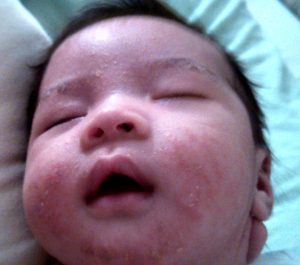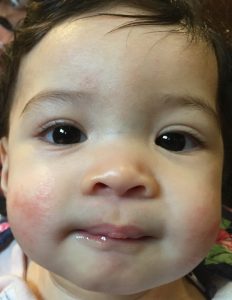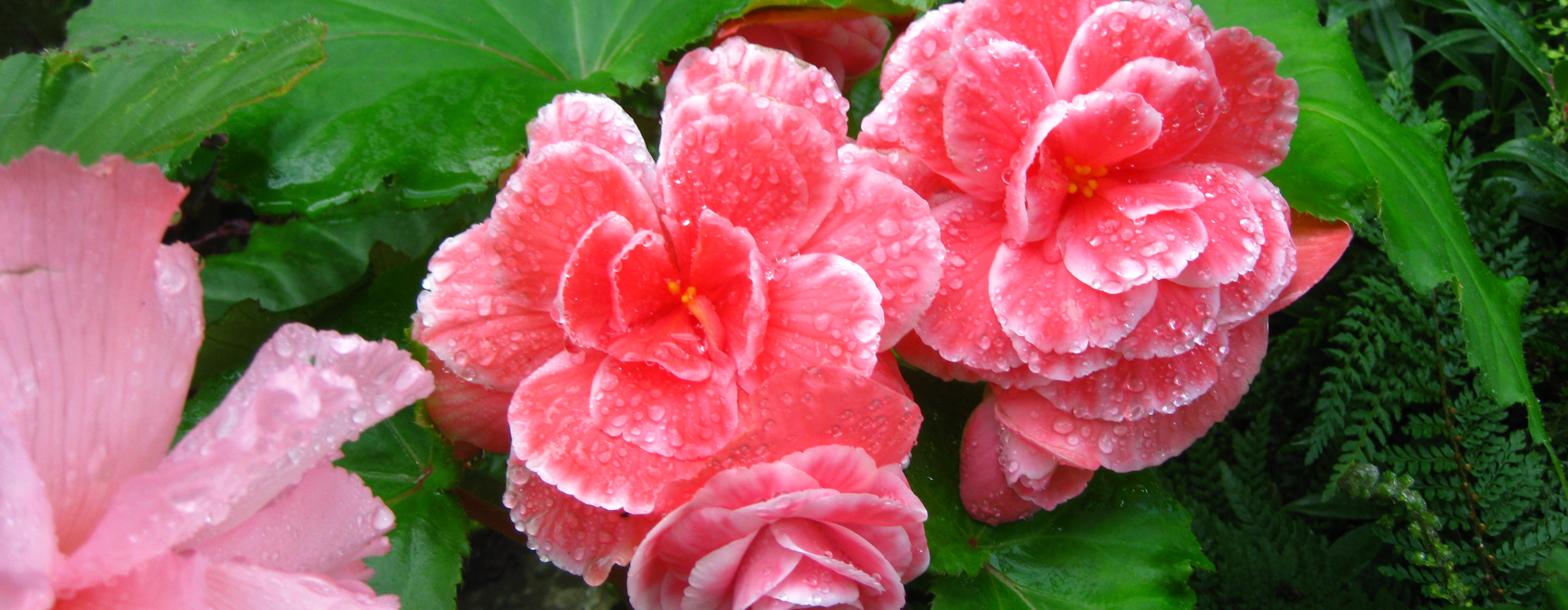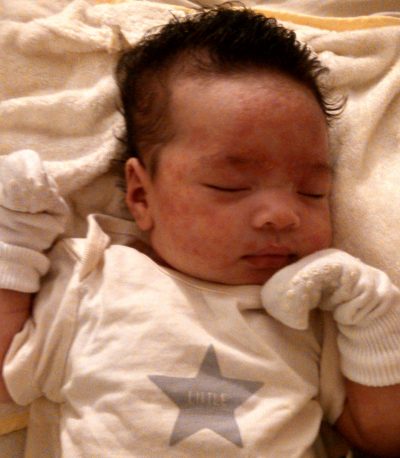About a month after Catherine was born, her skin changed practically overnight. Red, inflamed patches covered her face as well as behind her knees, inner elbows, and back. The rashes would vary in intensity of hue and would ooze and crust over. Yellow flakes formed on her eyebrows and scalp. Catherine would scratch herself whenever she could until the point of bleeding, so we had to keep mittens or socks on her hands to avoid infection.
When we brought her to her pediatrician, we were told that she had atopic and seborrheic eczema. Dandruff specific shampoo and more humid weather would most likely result in these issues resolving themselves. She was prescribed a topical steroid which was only to be used for relief purposes, not for healing the condition. We were warned that overuse of it could thin her skin. This combined with my fear of Catherine’s skin becoming steroid dependent led to my decision of initially refraining from using it on her.
While it helped to know exactly what we were facing, my mind was overcome with the reasons why this was happening in the first place. It broke my heart to watch as the eczema worsened over for the next 7 months. I felt so bad for my daughter that occasionally I’d offer her my body brush so that she could rub the hard to reach patches of itchy skin against it. Catherine was as desperate for relief as I was to find a cure.

To note, before Catherine’s eczema issues, her bath usually consisted of nothing more than filtered lukewarm water and a sea or konjac sponge. Every now and then I’d use a natural baby shampoo and corresponding conditioner on her hair. Unfortunately, this routine was insufficient.
I immediately started researching natural remedies. Among the first things I ordered following her diagnosis was a natural dandruff shampoo and conditioner set. Also, we had way too much coconut oil on hand so I slathered it on her scalp and eyebrows a few hours prior to bath time. This helped to soften any scales thereby making removal at bath time a lot easier. Those dandruff products along with religious application of coconut oil helped get rid of the cradle cap.
My next step was to a bit of a balancing act. Find something that would provide her relief but not further aggravate her inflamed, sensitive, dry, and itchy skin. I added various things to her bath water such as dead sea salts, lavender essential oil, and apple cider vinegar. I tried to allow for a few minutes of soaking time in hopes that it’d be beneficial for her skin. I’d generously apply raw cocoa butter, pure emu oil, grassfed tallow and emu creme balm, and the like a few times a day and especially after baths. Even though her skin was temporarily moisturized, there needed to be a lot more improvement.
For the next 7 months, I tried everything I could possibly think of to no avail. It broke my heart to see my baby so miserable. At one point, out of desperation, I caved in and used the steroid cream on her as well as a drugstore body wash and lotion. None of that worked.
One day, I was reading a Facebook post on Red Skin Syndrome/Topical Steroid Addiction/Topical Steroid Withdrawal when I stumbled upon two sites in the comment section that changed everything for us: Solveeczema.org and Isaiah Quinn. Of the former site, the third (The Problem) and fourth (The Solution) sections were extremely informative. The latter is a blog by Stephanie, owner of The Home Apothecary on Etsy, that details the story of her baby Isaiah’s arduous struggle with Red Skin Syndrome. With faith, the balms, and natural remedies Stephanie restored her son’s health.
Since all the products used in our household were nontoxic, I was surprised to learn about detergent sensitivity. Even detergents that were derived from natural sources could cause flare ups. I suppose, in this case, it’s as they say- not everything that is natural is good.
On a whim, I decided to do a patch test based on this concept. I washed a consistent trouble spot, Catherine’s inner elbow, with pure castile soap and lukewarm water. I then patted the skin dry and wrapped her elbow in medical gauze, using just enough medical tape to secure. After a few hours, I removed the tape to find that the patch had improved drastically in color and even looked less inflamed.
While an overhaul of everything in the house is a daunting task, I had done it before and was willing to do it again if it meant the end of my daughter’s suffering. I scoured the labels of every product in our home, looked up ingredients, and rounded up everything that had detergents. Same with all personal care and beauty products. I found soap based alternatives and set about cleaning every surface and washing everything in the sanitize cycle in an attempt to get rid of any remaining traces of detergents.
The final pieces of the puzzle were The Home Apothecary’s zinc balm paired with calendula balm and Goat Milk Stuff’s raw goat milk soap. These products were imperative components of Catherine’s healing journey and to this day I use only them for her skincare routine. The soap simultaneously cleanses and moisturizes skin. The zinc balm encourages the skin to refresh, essentially to start regeneration. Where the skin is too moist, zinc brings balance by drying. The calendula balm moisturizes and heals. I specifically asked for carrot seed oil to be added because it promotes healing, regeneration, and equilibrium. Without hesitation, I would suggest the balms and raw goat milk soap to anyone with eczema.
In the end, the positive progress we were making with this routine was confirmed at a pediatric dermatologist visit. When I scheduled that particular appointment, the earliest they could see her was at least two months away. Coincidentally, that’s when I found and purchased the goat milk soap and balm sets. I started using the products on Catherine at the end of May and her appointment was set for the middle of July. Her eczema improved drastically in that time frame but hadn’t gone away completely so I decided not to cancel.

After the doctor examined the remaining patches, she asked us what products we were using on our baby because Catherine’s case looked mild at worst. She went over some precautions and steps that might help those with eczema but we were already practicing them at home. The doctor didn’t see the need to prescribe anything and told us to continue doing what we were doing. We didn’t even need to bring Catherine to a follow up appointment because she only continued to improve. By the next month, all her patches were gone.
Additional Things to Consider
Humidity. Dry air, caused by things like cold weather or constant exposure to heating or air conditioning, leads to dry skin by drawing out moisture. We kept a warm mist humidifier running almost all the time, only turning it off to clean the unit (mineral deposits on the heating element being the main issue which white vinegar soaks will take care of).
Air quality. There may be allergens floating around in the air such as dust mites and pollen. I never gave this any thought until we lived in an old apartment building in NYC that had poor ventilation and I had my first sinus infection. We bought an air purifier after that and since then, I wouldn’t want to be without one.
Stop scratching. Incessant scratching will only damage the skin and disrupt the healing process. This might mean having to cover the hands and/or feet. In our case, Catherine still tried to claw at her face and so the sock covering didn’t work because cotton wasn’t gentle enough for her skin with the constant friction.
Go through household/personal care products. Sometimes it isn’t enough that a product is labeled hypoallergenic or unscented. Read ingredients lists and keep a lookout for any possible irritants.
Breathable clothes and bedding. Sweat can be a trigger for eczema flares and exacerbate itching. Minimize it by choosing loose, comfortable clothes made of breathable fabrics like cotton or bamboo. Fabrics that are moisture wicking are also beneficial in this case. For Catherine’s crib mattress, we chose one that has a waterproof surface that acts as a barrier to dust mites. We top it with organic cotton or organic bamboo fitted sheets. Since Catherine slept in our bed for the first few months, I switched to hypoallergenic and moisture wicking bedsheets and pillow protectors/encasements.
Moisturize. Dry skin can trigger eczema flare ups. Skin is less likely to heal if it’s constantly faced with such an imbalance; thus, it’s important to be consistent with a moisturizing regimen to combat dryness. We reapplied the balms to Catherine’s skin several times throughout the day and especially after baths when her skin was damp to lock in hydration.
Products That Helped
Zinc Balm & Calendula Balm (with Carrot Seed Oil)
The zinc and healing balm pair is a must. You can get the 8 oz set as in the link above or you can mix and match with the “it’s a BIG deal” offer. I was able to have carrot seed oil blended into the calendula balm free of charge. Stephanie can customize the balms to your liking whether that means adding or avoiding certain ingredients. In terms of usage we would first apply the zinc balm (which is thick and has a paste texture so not much is needed) on all eczema spots, adding a little more to any that were oozing/weepy. Second, we generously slathered calendula balm all over but especially so on any areas that were on the drier side. Lastly, the worst patches would be covered with sterile gauze that was secured with medical tape. This process was repeated anywhere from two to three times a day depending on the current condition of Catherine’s skin and always after a bath.
Purity Goat Milk Soap (unscented)
*http://bit.ly/2nTkCKV or http://etsy.me/2oRo5uC (optional Soap Savers)*
Since soaps can be drying, I sought a pure formulation made with some type of moisturizer. I read about how raw goat milk contains skin nourishing qualities: vitamins, minerals, cream, and alpha hydroxy acids. If you look at the ingredients list, it doesn’t get any more pure than that. Since the soap comes in bars, I cut off a piece and place it in a soap saver. Soap savers, made of either mesh or fabric, help you get the most of bar soaps and prolong their lifespan. Just put the pieces of soap inside, wet, and it lathers when you rub it against your skin. After, simply rinse the soap saver and hang to dry. No more wasting bar soap when it gets worn down to little pieces or letting it sit on a surface and getting slimey. Lastly, I highly recommend their “Essential Oil Soap” section (lavender and almond..mmm!) for those who want the added benefit of aromatherapy sans any synthetic fragrances.
ScratchMeNot Flip Mitten Sleeves
We initially used socks on Catherine’s hands when she was a newborn to prevent accidental scratching. However, when her eczema started to kick in, even organic cotton was harsh on her skin. Also, Catherine was able to get them off her hands. We got the ScratchMeNot sensitive version where the sleeves are made of cotton while the mittens on the end are silk. It wears like a cardigan and can be worn under or over anything and easily removed or put on. Not wanting to deprive Catherine of a chance to refine her motor skills, we just flipped the ends open and when she was finished with whatever task we would flip them closed. She wasn’t able to take this off herself and so the ScratchMeNot helped give her skin the chance to heal.
Cradle Cap Scalp Massaging Brush
We tried to use a fine tooth comb to gently remove the scales from cradle cap on Catherine’s head, but this wasn’t efficient and irritated her scalp. The bristles on this brush are soft and don’t scratch skin when used with gentle pressure. The comb easily removes flakes and distributes shampoo and conditioner evenly into the hair and scalp.
Organic Virgin Coconut Oil (Gold Label)
http://bit.ly/2oT11Ph (FAQ on different types offered)
We use this specific coconut oil because it’s unrefined, hand made, and wet-milled from fresh coconuts which maintains high levels of antioxidants. We bought this in bulk about a year prior to having Catherine using it for health and culinary purposes. Some uses include oil pulling, hair treatments, and adding to your coffee or tea for some healthy fat.
The particular model we picked was the Vick’s Warm Mist Humidifier for performance, cost, and no requirement for additional parts. It boils water, either tap or distilled, to a pure steam. Just be sure to clean out whatever humidifier you are using on a regular basis. For the model we chose, we clean it with a diluted white vinegar soak for at least a few hours or overnight. This removes any mineral build up that can result from using tap water.
Air quality is just as important as maintaining an ideal humidity level. As mentioned prior, poor ventilation coupled with an old building proved detrimental to my immune system. Even after taking antibiotics for a sinus infection, my body continued to show symptoms of weakened immunity. It wasn’t until after the introduction of an air purifier into our home that they started to ease. The Rabbit Air MinusA2 is energy efficient, offers decent room coverage, and has a unique filter system. The filters need only be replaced once every year if you run the unit all day or once every two years if running the unit for 12 hours each day. We use the germ defense option, which filters out things like mold and airborne bacteria.

